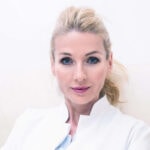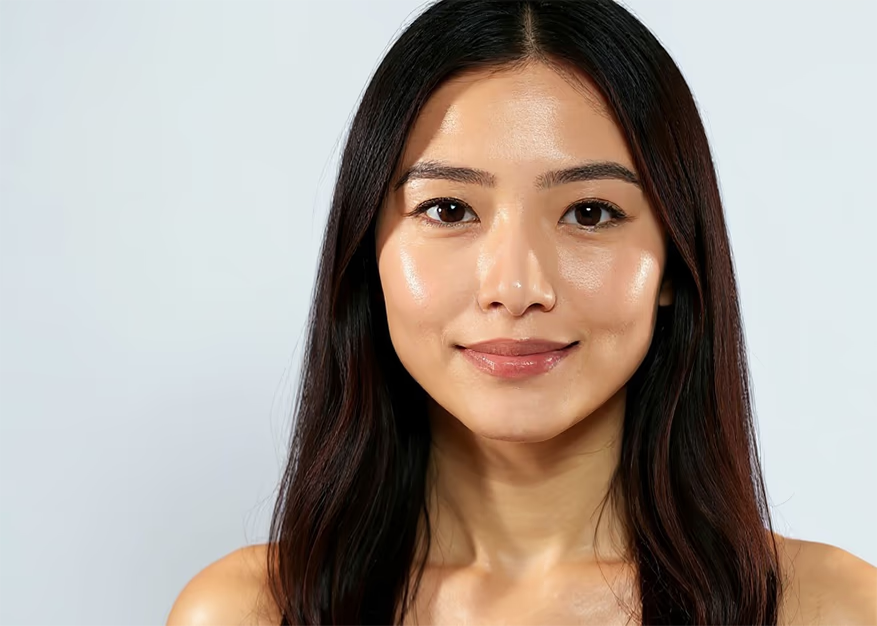Correcting the Nasolabial Fold with Hyaluronic Acid
The nasolabial fold is a concise line that forms from the nose to the corner of the mouth. It is present in every human face and thus distinguishes us from primates. Its name is composed of the Latin terms “nasus” for nose and “labium” for lip. The nasolabial fold visually connects the nose and the corners of the mouth into a more or less distinct triangle.
A pronounced nasolabial fold is typically a result of the natural aging process, but can also be exacerbated by weight loss, smoking and sun exposure.
Many people find the nasolabial fold disturbing and want to have it removed, especially if it is pronounced and runs as a distinct bulge between the cheek and mouth. In such cases, it can be smoothed with the help of various methods of wrinkle treatment.
The preferred treatment is injecting with hyaluronic acid. For optimal results, however, the actual cause must usually be treated as well, namely the sagging of slack cheek areas due to aging.
In this article I describe how I proceed in my practice in Munich with patients who want to have the nasolabial fold injected.
These are the topics:

How Does the Nasolabial Fold Develop?
The nasolabial fold is caused by multiple muscles and is the result of various facial expressions. It is most prominent when smiling warmly, which is why it is also referred to as the “smile line” in German.
It is already present in the youthful face and contributes significantly to the three-dimensionality of facial expressions. However, in younger years, it is rarely perceived as bothersome unless it appears as a distinct furrow due to genetically determined strong muscle tension (muscle tone).
In such rare cases, it can be temporarily smoothed with Botox to prevent further deepening. However, the typical age-related nasolabial fold cannot be successfully treated with Botox alone.
During the aging process, the nasolabial fold becomes noticeably deeper due to the relaxation of connective tissue and the resulting destabilization of fat tissue and ligaments. The nasolabial fold is located at the transition between the fat-rich cheek area and the fat-poor mouth region.
In this area, two opposing movements occur: the pull exerted by the ligaments on the skin of the mouth region, and the pressure exerted by descending cheek fat.
As a result, the descending skin forms a fold that extends more or less visibly from the nostril to the upper lip and appears as a deep furrow at the transition between the mouth and cheek regions. The depth of this furrow correlates closely with the degree of cheek laxity. For optimal aesthetic correction, it is therefore necessary to compensate for the sagging of the cheeks.
Nasolabial Fold Augmentation with Filler
Injecting hyaluronic acid into the nasolabial fold is the preferred method when it is primarily caused by volume loss. This treatment can restore facial harmony. However, it should not be overcorrected to achieve complete smoothness, as it would compromise the natural three-dimensionality of the face. Overfilling the nasolabial fold would make the face appear flat and swollen, resembling a “moon face” in the worst case.
The wrinkle treatment begins with a comprehensive examination and discussion of risks. The nasolabial fold is one of the high-risk areas in the face where serious complications such as necrosis and blindness can occur after filler injections, although they are rare. The region of the canina fossa, located on the sides of the nostrils, is particularly risky.
Important arteries run through this area, and accidental puncture would have severe consequences. However, it cannot be avoided during the treatment because the shadow cast by the nasolabial fold is often most prominent in this region. Therefore, risks must be explicitly addressed during the informed consent process, and the patient should be able to decide whether the anticipated results are worth taking these risks.
Next, the treatment area is anesthetized, followed by thorough cleansing and disinfection. Infection caused by bacteria introduced into the tissue with the needle is another complication of filler treatments that must be considered and minimized through maximum cleanliness.
Superficial and Deep Correction

The correction with hyaluronic acid filler is performed in two ways: Superficially by injecting it into the skin to camouflage clearly visible and permanent lines with small amounts of filler. And also by injecting it into the muscles to support the actual “fold” and achieve a harmonious lifting effect that gently blends the mouth and cheek regions. This can be done using sharp or blunt cannulas. I, personally, prefer the blunt cannula.
First, a hole is punctured with an injection needle, approximately 1 cm to the side and below the corner of the mouth. Through this hole, the blunt cannula is then inserted beneath the muscle towards the nose. As the cannula is withdrawn, hyaluronic acid filler is gradually deposited, totaling 0.3-1 ml per side. To lift the surrounding tissue as well and create a visually harmonious result, the treatment is not limited to just the nasolabial fold but extends at a sharp angle to it. To minimize pain, the area can be locally anesthetized before the procedure, and the filler products I use also contain lidocaine as a pain reliever.
As mentioned before, the primary cause of the nasolabial fold is often in the cheek region. Therefore, it is recommended to replace the lost volume in the cheek area with filler injections and tighten the skin from the cheeks, creating a “liquid lifting” effect. Ultimately, the nasolabial fold is not only lifted through direct injection, but also “pulled up” by the achieved skin tightening from the cheekbones. The result of such a combined treatment appears more pronounced and natural than simply injecting the nasolabial fold alone.
Additionally, the marionette lines, which run downwards from the corners of the mouth, can also be injected. They are often prominent in cases of pronounced nasolabial folds and extend the nasolabial fold downward, forming a diamond shape with the lips in the center.
As a further complementary treatment, liposuction may be considered if the bulge of the nasolabial fold contains significant amounts of subcutaneous fat. These fat deposits can be significantly reduced in 2–3 sessions with liposuction, which, when combined with filler injection, creates a much more youthful and dynamic facial expression.

Risks and Complications
The region around the nasolabial fold is one of the high-risk areas for facial filler treatments. It is involved in about one-third of the few cases of blindness caused by filler treatments.
This makes it the second most common application with such disastrous consequences, following the injection of the glabella (frown lines), which accounts for approximately half of the globally reported cases of blindness.
While this complication rarely occurs, it is crucial to recognize that not every purpose justifies the means when injecting in such a facial region. If realistic aesthetic improvements cannot be achieved to justify taking such risks, the treatment should not be performed.
A more common complication is swelling, redness, and often bruising, which usually lasts only a few days. However, some individuals are sensitive to hyaluronic acid fillers, and this sensitivity can manifest weeks, months, or even years after the injection.
In cases of delayed allergic reactions, persistent swelling, typically inflammatory and painful, can occur. Treatment involves initially administering corticosteroids and, if unsuccessful, dissolving the injected hyaluronic acid with Hyaluronidase.
How Long Does The Result Last?
Since I exclusively use premium fillers with a long lifespan in my practice in Munich, the expected duration of the result is about 9–12 months. In some of my patients, a noticeable improvement was still visible after 18 months compared to the initial state. However, it should be noted that the longevity of the result is also heavily influenced by individual factors such as facial expression and metabolism. Even in unfavorable cases, I would expect the result to remain visibly significant for at least 8 months and gradually fade thereafter.
Other Treatment Options
There are several options for treating a nasolabial fold. The main alternatives to augmentation with hyaluronic acid filler are:
Thread Lifting
If the skin laxity is not too advanced, a lifting procedure using strong threads such as Silhouette Soft may be an option. The results are often impressive and comparable to surgical facelifts, with a noticeable reduction in the nasolabial fold. Thread lifting can be used to treat the nasolabial fold by lifting and tightening the skin. Special threads are inserted beneath the skin and then pulled to lift and tighten the skin.

There are different types of threads that can be used, such as PDO (Polydioxanone) threads or Silhouette Soft. The threads I use for my patients in Munich are fully absorbable and are implanted under local anesthesia.
The advantages of thread lifting are that it is a minimally invasive procedure, does not require general anesthesia, and has a short recovery time. However, it is important to note that the results may not last as long as with a surgical method, and it may take some time to see the full effect.
Therefore, it is important to receive thorough consultation from a qualified physician to ensure that the treatment delivers the best results for individual skin and the type of fold.
Microneedling, PRP, Mesolift
Early and superficial nasolabial folds can be effectively treated with medical microneedling. During this procedure, the skin is punctured with hundreds of fine needles in its deeper layers under local anesthesia. This stimulates the body’s natural healing process, leading to the production of new collagen, elastin, and hyaluronic acid.
As a result, the skin becomes tighter and the appearance of the nasolabial fold is reduced. To achieve visible results, deep needling and local anesthesia of the face are necessary.
Additionally, the treatment needs to be repeated every 4 to 6 weeks. Typically, 2–4 sessions and an annual touch-up are required for optimal results.
For a faster and enhanced effect, a combination of microneedling and platelet-rich plasma (PRP) can be used. This autologous therapy, commonly known as “Vampire Lifting,” stimulates collagen and elastin production while providing concentrated growth factors to the treated area.
Another treatment option in the same category is a mesolift using firming substances such as the popular NCTF. In addition to stimulating collagen synthesis through numerous needle punctures, these substances provide the body with the necessary components for rapid skin regeneration.
Laser, RF, HIFU
Laser treatments can also be used to tighten the skin and smooth out wrinkles. However, when it comes to age-related nasolabial folds, lasers may only be partially successful if the sagging tissue in the cheeks is not addressed.
During laser treatment, the skin is stimulated by heat to produce new collagen and elastin, resulting in skin tightening and wrinkle reduction. There are different types of lasers that can be used for treating nasolabial folds, such as CO₂ lasers or erbium lasers. It is important to have a thorough consultation with a qualified physician before undergoing laser treatment to ensure that the appropriate laser type and settings suitable for your individual skin type are selected.
The same applies to other procedures such as radiofrequency (RF) or high-frequency ultrasound (HIFU), where thermal energy is used to induce collagen fiber coagulation beneath the skin using a different physical method than lasers. However, the principle remains the same. The advantage of RF and HIFU over lasers is that they work independently of skin type, reducing the likelihood of epidermal damage.
Botox
Botox is used in wrinkle therapy when muscles that contribute to the formation of wrinkles through facial expressions need to be relaxed. However, in the case of nasolabial folds, there is rarely a need for Botox treatment, except when the folds are caused by excessive muscle tension at a young age.
This condition can also be present in older age, which may warrant a combination of Botox treatment in addition to filler injections. However, Botox alone will not achieve satisfactory results for age-related nasolabial folds.
Surgical Intervention
A surgical facelift may be necessary, especially when tissue loss in the midface is advanced to a point where it cannot be adequately compensated for with fillers. In such cases, the nasolabial fold is the result of genuine excess skin. This condition can only be corrected by surgically removing the excess skin and tightening the skin across the entire midface. Due to the associated risks and significant costs, surgical intervention should only be considered as a last resort.
What Is The Cost Of Augmenting The Nasolabial Fold?
Augmenting the nasolabial fold with hyaluronic acif filler costs approximately €450-€500 in my practice in Munich. For this procedure, I use a premium filler such as Juvederm Voluma, with a total filler volume of 1ml. In more advanced cases, however, 2ml is usually required, which would increase the cost to around €850.
If the cheeks are to be treated as well to further improve the results through skin tightening, approximately 4ml of hyaluronic acid is typically necessary. The cost of this treatment would then be approximately €1,650. Similarly, the cost of a cheek lift using Silhouette Soft threads, which I consider as a potential alternative to hyaluronic acid injections, would be comparably high.
A microneedling treatment would amount to around €1,000 if three sessions are considered. The treatment with PRP and microneedling (Vampire Lift) would cost approximately €1,400, also for three sessions. In all cases mentioned, the additional treatment with the fat-dissolving injection would incur additional costs of approximately €200 per session.
Please note that all price estimates provided are indicative and only for orientation. Individual billing for treatments is always based on the German Medical Fee Schedule (GOÄ).

About the Author:
Dr. med. univ. Eva Maria Strobl is the owner of LIPS and SKIN Aesthetic Medicine practice in Munich. She is a trained specialist in general medicine (MedUni Vienna) and has over 10 years of specialization in non-surgical aesthetic procedures. Dr. Strobl is a member of the German Society for Aesthetic Botulinum Therapy e.V. (DGBT), the German Society of Anti-Aging Medicine e.V. (GSAAM) and of Network Global Health. She publishes regularly on her blog and on DocCheck.
Sources of this Article:
Sattler et al, Fillers in Aesthetic Medicine, KVM Publishers.
De Maio, MD Codes™: A Methodological Approach to Facial Aesthetic Treatment with Injectable Hyaluronic Acid Fillers, Link.
Seo, Facial Volumization with Fillers, Springer

